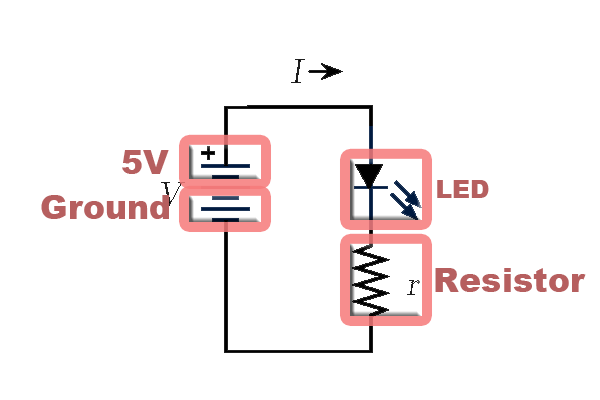
As mentioned earlier, Arduino consists of two major parts: the hardware (the Arduino board) and the Software (the IDE). The advantage of using the Arduino is that we can build a circuit and then modify how it responds by changing the code (instead of changing the hardware). The focus of this lab will be on building a basic circuit with an LED. We will then examine the code that makes the LED blink.
At the end of this lab, you will make the LED blink Morse Code—all through the magic of code!
So you don't have to solder things together, you will temporarily build your lab circuits on the breadboard provided with your ARDX kit and change the code to modify how the device responds.
In your class, you have been discussing a basic circuit that has the following components (circled in pale red):

If we want to use the Arduino to control the light, we can modify the above schematic diagram to the following:
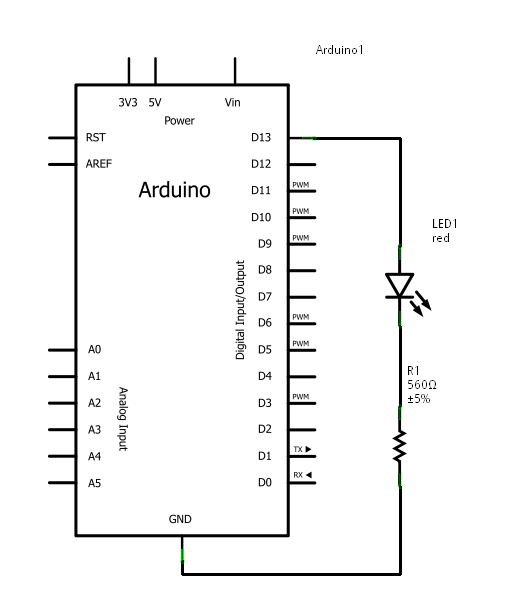
This circuit calls for two pieces of hardware in addition to the Arduino, a red LED and a 560Ω resistor. LEDs are the lights in your kit, and a red one should be easy to find, so take one out now. The resistor might be a bit trickier because resistors are labeled with stripes instead of numbers. So let's learn a bit about resistors so we know why they are used, and can pick the right one for the diagram.
Resistors are one of the most common electronic components so let's explore how they work.
Unlike the LED and some other electronics components, resistors can be connected in any direction - they don't have positive and negative leads.
Resistors reduce the flow of electricity, or current, in a circuit. All electrical components resist to some degree, even wires, but resistors are designed specifically for that purpose.
When you complete a circuit that has no resistance, current will flow through it as fast as the power source can provide it. If you have a source with a lot of available power this results in heat which may burn you or melt and ruin electrical components. A common metaphor for electrical current is water in pipes. If you have a pipe that is open to air, this is a bit like a circuit that is connected to ground. If you have a high pressure source and a wide pipe then a lot of water will flow through the pipe to air. If there is a narrow spot in the pipe somewhere this will slow the water and less water will flow out of the pipe where it opens to air. Sometimes you want a lot of water to flow to air, as in a fire hose. Sometimes you want a little water to flow to air, as in a water fountain. The same goes for electricity. Sometimes you want a lot of current because you are driving a motor. Other times you want only a little because you are driving a small LED.
In class you will learn about Ohm's law:
V = IRand how it relates:
Resistors are used to:
The last point is kind of complicated. Over the next two weeks we are going to make use of this voltage adjustment property. This week we'll use resistors to adjust current through an LED.
Resistance to current is measured in ohms. Ohms are represented with the greek symbol Omega (Ω). You saw this symbol in the circuit schematic above. When a circuit diagram calls for a resistor with a certain resistance it is important to get the right one.
Resistors come in a very wide range of values. They are also typically very small. So rather than trying to print a resistor's value directly on its case, a color coding system is used. This same color system is sometimes used for capacitors too, so it's a good idea to learn it. The system goes like this:
The first three bands express ohms in scientific notation. The number represented by the first two bands is multiplied by 10 to the power of the number on the third band. Another way of thinking of this is the number represented by the third band represents how many zeros follow the numbers represented by the first two bands.
The last band represents the margin of error in the resistance value.
If you find a resistor with 5 or 6 bands, or with a strange colour, you can try this Resistor color code calculator from Hobby HourSo, what is the smallest possible resistance value in this system? (hover over the line below to reveal the answer)
00x100Ω or 0Ω
What is the largest? (hover over the line below to reveal the answer)
99x109Ω or 99,000,000,000Ω
Here are a few examples from the ARDX kits. See if you can correctly identify them from their colors. Hover over the lines below each resistor to reveal the answer.
 green blue brown gold 5 6 1 5% — 56x101Ω — 560Ω ±5% |
 red red red gold 2 2 2 5% — 22x102Ω — 2,200Ω ±5% |
 brown black orange gold 1 0 3 5% — 10x103Ω — 10,000Ω ±5% |
Take the correct resistor out of your ARDX kit.
Now that we have our components picked out, let's take another look at how they are supposed to be connected:

Notice that the schematic shows the circuit starting at pin 13 which can be controlled to turn the LED on and off. GND represents ground and is not actually in that place on the board (but it makes a nice diagram). More realistically, your board will look like this:
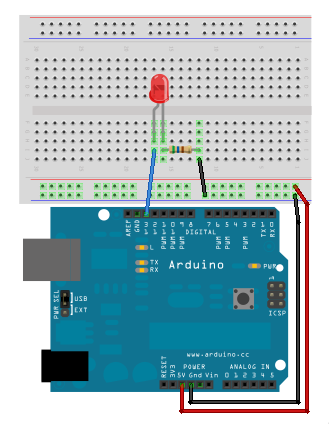
As discussed in class, you can put the resistor on the other side of the light and you will still get the same results.
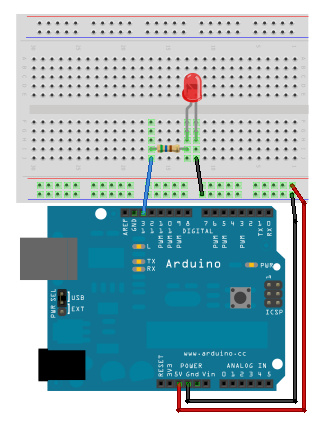
Or, you can save one wire by turning the resistor 90° to get a layout that looks like this:
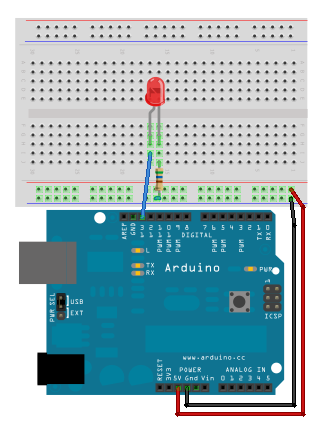
Now, it's your turn to build this circuit. Try one or all of them.
Something to watch for:
Aside: These breadboard diagrams were created using Fritzing. This is a great way to document what your breadboards look like when you are working on your project. To get Fritzing: http://fritzing.org/download/ The following is a fritzing file: led_resistor_lesswire2.fz. If you want to play around with it (after downloading Fritzing), right click and save it to your desktop. |
Under the File menu, choose: Examples | Basics | Blink.
This is the code from last week:
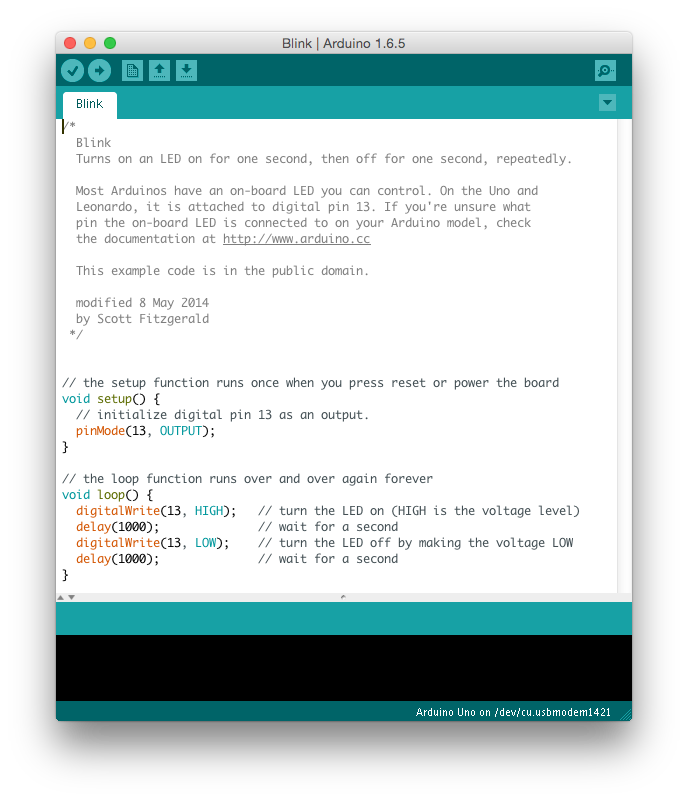
Let us try running the code:
The LED part of your circuit might look like this:
The resistor is used to prevent damage to the LED. It reduces the current coming from the output pin to a level that is safe for the LED. Technically, it is not needed in this circuit because pin 13 has a resistor built in. However, If you use an LED with any other output pin you should use a resistor.
Adjust your wires so the resistor is no longer in the circuit .
What do you notice?
You can use different values of resistors to adjust the brightness of your LEDs. For the 5V Arduino source and the LEDs in your kits, resistors from 300Ω to 10,000Ω are safe and allow a wide range of brightness levels.
How do you know what values of resistor to use with an LED? The answer is a bit complicated and involves Ohm's law. It depends on the voltage of the power source and the type of LED you are using. Click here for a web page that has a good discussion of the topic.
A sketch is the fancy name that Arduino uses to mean a program or code. It is written in text—just like a document. For those of you who would like to know, sketches are C/C++ based. When you sucessfully Compile/Verify the program, it is translated to Arduino machine-language, which is not human readable. So, let us look at the Blink program in detail:
/*
Blink
Turns on an LED on for one second, then off for one second, repeatedly.
Most Arduinos have an on-board LED you can control. On the Uno and
Leonardo, it is attached to digital pin 13. If you're unsure what
pin the on-board LED is connected to on your Arduino model, check
the documentation at http://www.arduino.cc
This example code is in the public domain.
modified 8 May 2014
by Scott Fitzgerald
*/
// the setup function runs once when you press reset or power the board
void setup() {
// initialize digital pin 13 as an output.
pinMode(13, OUTPUT);
}
// the loop function runs over and over again forever
void loop() {
digitalWrite(13, HIGH); // turn the LED on (HIGH is the voltage level)
delay(1000); // wait for a second
digitalWrite(13, LOW); // turn the LED off by making the voltage LOW
delay(1000); // wait for a second
}
You may notice that many of the lines have a semi-colon (;). Semi-colons are the way of indicating the end of a statement; similar to how we use a period (.) to end our statements. The semi-colon is important--if you forget one, then your code will not Compile/Verify.
Comments are like reminder notes of what is going on in the code. Comments are ignored by Arduino, but are a highly recommended addition to your code. Comments remind you what you have done and make it easier for someone else to understand what your code is doing.
There are two forms of comments demonstrated in the code above:
/* */ - Anything that is between the opening slash-star /* and the closing star-slash */ is ignored by Arduino. These are good for comments that go over several lines. In this example they are used around the Header Comment// - Everything on after the double-slash // on a line is ignored by Arduino. These are good for short reminders at the end of a line.Here are some tips for using comments:
/* */ comment is an example of a header comment. You should write a header comment at the top of any sketch you write to remind you of details you may have forgotten since you last used it. Typical header comments include:
// comments. You write them to explain a potentially complicated part of your code. For beginners this might be everything, so the basic sketches have lots of in-line comments.Notice that the sketch uses the number 13 every time it refers to pin 13. Imagine a very long program that uses pin 13 hundreds of times. Now imagine that you needed to use pin 9 instead. You would have to find and fix every reference to pin 13. We can use a symbolic name to refer to the pin instead.
int led = 13;
// the setup function runs once when you press reset or power the board
void setup() {
// initialize the led pin as an output.
pinMode(led, OUTPUT);
}
// the loop function runs over and over again forever
void loop() {
digitalWrite(led, HIGH); // turn the LED on (HIGH is the voltage level)
delay(1000); // wait for a second
digitalWrite(led, LOW); // turn the LED off by making the voltage LOW
delay(1000); // wait for a second
}
Take a closer look at the declaration of led. It looks like this:
int led = 13;
This is a declaration to say "that we would like to create a box named led and put the number 13 in that box." (http://www.ladyada.net/learn/arduino/lesson2.html). Notice that int indicates that the type of box is an integer. After the declaration, you use led where you had 13 before.
You can learn more about using variables in the Arduino Foundations Tutorial. The int data type is just one of many that you can use in your Arduino programs. You can learn more about it and other Arduino data types by reading the links under the section on Data Types on the Arduino Language Reference page. In these labs you will mostly use int, float, char, byte and String, so you should read up on them.
Try: Change the sketch to blink an LED on pin 9 instead of pin 13. What all do you have to change in order to get your light to blink?
We will be looking at procedures in detail in a later lab. For now, you can interpret procedures as a collection of statements that are grouped by a task. To mark the beginning and ending of the grouping, an opening curly bracket ( { ) and closing curly bracket ( } ) are used respectively instead of a semi-colon (;). Arduino expects two procedures in every program:
setup()- any statements in this procedure will be executed once at the beginning of your program (when it is uploaded or when the Arduino wakes up after being reset).loop()- any statements in this procedure will be executed over and over again forever,
or at least until you turn your Arduino off or upload something new.
The statements in this procedure are the core of what you want your
Arduino program to do.We will look at the statements within these two procedures in detail in the next two subsections.
Remember, the statements within setup are executed once at the beginning of your program. In our example code, there is only one statement within this procedure:
pinMode(led, OUTPUT);
This statement tells Arduino to "setup" the led
(originally pin 13) as an OUTPUT pin. OUTPUT means that a voltage will
be sent out from the pin, thus controlling our LED. The other option
(not used in this lab) is INPUT, which means that a voltage will be
read from the pin. Any of the digital or analog pins can be used for
output. Pins 0 and 1 should be avoided in most projects because they
are used to communicate with the computer (TX and RX). The analog pins,
A0 to A5, can be referred to by those names or as pins 14 to 19 respectively when you use the pinMode statement.
Remember, the statements within loop are executed over and over again forever. The guts of what we want our program to do are inside this procedure. The two major statement types are :
digitalWriteHIGH (pulled to +5V) to the led (originally, pin 13).
LOW (pulled to 0V) to the ledOUTPUT (as was done in the delay
The digitalWrite command will only set your LED to on or off. If you want to set your LED to different brightnesses you can use analogWrite. It works a lot like digitalWrite, except you use a number from 0 to 255 to indicate brightness. For example:
analogWrite(9, 128);
would make a LED on pin 9 to glow at half brightness. It does this
by switching the output pin between HIGH and LOW within a short period
of time. The higher the number you give to analog write, the longer the
output is high relative to low. If you use 0, the pin is always LOW,
and if you use 255, the pin is always HIGH. This technique is called
PWM (Pulse Width Modulation) and it only works on the PWM pins: 3, 5,
6, 9, 10, and 11.
Complete the Resistor Colour Codes quiz in URCourses
Well, you now know how to make a light blink.
What can we do with a blinky light? How about making a message with Morse Code?
You have the choice of making SOS or the initials of your name.
Please use any pin other than pin 13 for this exercise.
Morse code is made of a combination of 5 elements:
| Dots (or Dits) | 1 unit of time |
| Dashes (or Dahs) | 3 units of time |
| Pause after Dots or Dashes (while building a letter) |
1 unit of time |
| Pause after Letters | 3 units of time |
| Pause after Words | 7 units of time |
Let's say that 1 unit of time is 240 milliseconds. But it could change so make this a variable (called uTime). At the top of the code, you will have:
int uTime=240;
Then when you are using delay, you can write:
delay (uTime);
or
delay(3*uTime); //if you want 3 units of time
To make SOS, an S is three dots and an O is three dashes. To break this down by timing:
| Letter | LED state | Delay Time |
|---|---|---|
| S | on | 1 unit of Time (dot) |
| off | 1 unit of Time | |
| on | 1 unit of Time | |
| off | 1 unit of Time | |
| on | 1 unit of Time | |
| off | 3*1 unit of Time (end of letter) | |
| O | on | 3*1 unit of Time (dash) |
| off | 1 unit of Time | |
| on | 3*1 unit of Time | |
| off | 1 unit of Time | |
| on | 3*1 unit of Time | |
| off | 3*1 unit of Time | |
| S | on | 1 unit of Time |
| off | 1 unit of Time | |
| on | 1 unit of Time | |
| off | 1 unit of Time | |
| on | 1 unit of Time | |
| off | 7*1 unit of Time (end of word) |
If you want to make your initials instead of SOS, you can use this Morse code chart here:
http://en.wikipedia.org/wiki/File:International_Morse_Code.svg
Pick a challenge that matches your skill level. I will set my expectations for future challenges based on what you do here.
Beginner
Intermediate
Advanced
During this lab:
In URCourses before next lab:
ledPin, uTimeOptional: